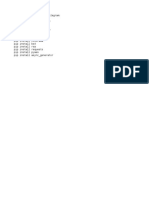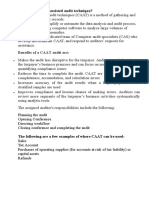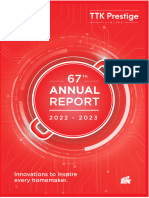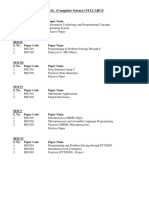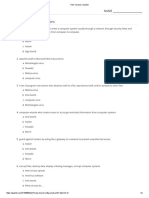100%(1)100% found this document useful (1 vote)
7K viewsTermux Basic Commands
The document provides summaries of common Linux commands for navigating directories (cd), listing files and folders (ls), copying files (cp), moving files and folders (mv), removing files and folders (rm), installing and updating packages (apt), changing file permissions (chmod), installing tools from URLs (git, wget, curl), and displaying network interface information (ifconfig). It includes the main purpose and most common usage examples for each command across 14 sections.
Uploaded by
Ujjal MandalCopyright
© © All Rights Reserved
Available Formats
Download as TXT, PDF, TXT or read online on Scribd
100%(1)100% found this document useful (1 vote)
7K viewsTermux Basic Commands
The document provides summaries of common Linux commands for navigating directories (cd), listing files and folders (ls), copying files (cp), moving files and folders (mv), removing files and folders (rm), installing and updating packages (apt), changing file permissions (chmod), installing tools from URLs (git, wget, curl), and displaying network interface information (ifconfig). It includes the main purpose and most common usage examples for each command across 14 sections.
Uploaded by
Ujjal MandalCopyright
© © All Rights Reserved
Available Formats
Download as TXT, PDF, TXT or read online on Scribd
You are on page 1/ 2
*********************** cd commands *********************
What is cd ?
cd means change the directory and cd used for change the directory of terminal.
There are six Commands of cd
1. cd (change directory)
2. cd - (Move one directory back from where you are now)
3. cd ~ (Move to users have directory from anywhere)
4. cd .. (Change current directory to parent directory)
5. cd -- (Show last working directory from where we moved)
6. cd / (Change to root directory)
********************** ls Commands **********************
What is ls ?
ls list all current folders and directories
There are 12 commands of ls see what they are
1. ls (list current directory /list folder contents)
2. ls -l (To show file or directory, size, modified date and time, owner of file,
permission)
3. ls -a (List all files including hidden files )
4. ls -lh (It show size in human readable format)
5. ls -F (Used to add the '/' character at the each directory)
6. ls -r (Used to display files , directories in reverse order)
7. ls -ltr (Used to show latest modified directory or file date)
8. ls -n (to display UID and GID directories)
9. ls -i (Display number of file or directory)
10. ls -R (Show recursively list of sub directories)
11. ls -al (Formatted listing with hidden files)
12. ls --version (To check the version of ls command)
********************* cp commands *********************
What is cp ?
cp means copy, cp used for copy any type of files folders. The following commands
shows different types of cp commands.
There are 6 commands of copy
1. cp (used to copy any files, folders)
2. cp -f (Force copy by removing the destination files)
3.cp -v (Used to print informative message)
4. cp -u (Used to copy when source is newer than dest)
5. cp -R (Used to copy any directory "including hidden files")
6. cp -n (No file overwrite)
********************** mv commands *********************
What is mv ?
mv means move and it's used for move files and folders
There are six commands of mv
1. mv[Filename] (Used to move any files, folders)
2. mv -f (Force move by overwriting destination files without promote)
3. mv -v (To move any directory, folders)
4. mv -u (Update -move when source is newer than destination)
5. mv -i (Interactive prompt before overwrite)
6. mv [File1][New File2] (Used to move or rename file one to file 2)
******************** unstall commands ********************
What is rm ?
rm means remove and it's used for remove or delete files.
There are 5 commands of rm
1. rm (To remove or delete files)
2. rmdir [Dir name] (To remove any directory)
3. rm -rf (used to force remove a directory)
4. rm -r[Name] (Delete a directory called name)
5. apt remove [Package name] (Used to remove package)
************ package installation commands *************
What is apt ?
apt is a commandline package manager and provides commands for searching and
managing as well as querying information about packages. It provides the same
functionality as the specialized APT tools.
1. apt update (Used to update list of packages)
2. apt upgrade (To upgrade list of packages)
3. apt install <package> or pkg install <package> (to install packages)
*************** file permission commands ****************
What is chmod ?
chmod is used to change file permission to make file in executable mode)
There are 5 commands of chmod
1. chmod +x [File name] (Used to give permission{Make executable} to a file or
script like .py .sh .rb )
2. chmod +x * (Set file permission to all files)
3.chmod 771 [File name] (Set file permission)
4. chmod 777 [File name] (Give executable permission to a file)
5. chmod 777* (Give executable permission to all files)
***************** Installation of Tools ********************
git clone [url] (To install tools or script for github)
wget [url] (To install tools or script from any other website)
curl [url] (To install tool or script for termux)
*************** Basic Network Commands ****************
ifconfig (Shows configuration a network interface for check your local IP, mac
address or display the current network interface information)
You might also like
- 300+ Powerful Termux Hacking Tools For Hackers88% (26)300+ Powerful Termux Hacking Tools For Hackers16 pages
- 101+ Termux Commands List For Android 2021 (Best Ultimate GuideNo ratings yet101+ Termux Commands List For Android 2021 (Best Ultimate Guide15 pages
- Termux Tutorial Complete Termux Commands - Code100% (6)Termux Tutorial Complete Termux Commands - Code3 pages
- Hack Wifi Using Termux in Android Phone (Needroot)100% (3)Hack Wifi Using Termux in Android Phone (Needroot)3 pages
- Install Kali Linux On Android Without Root - HTML100% (1)Install Kali Linux On Android Without Root - HTML19 pages
- Termux Hacks Guide - Commands, Tools and Tutorials - Cybarrior100% (2)Termux Hacks Guide - Commands, Tools and Tutorials - Cybarrior5 pages
- How To Install Kali Linux On Android Without Root (Full Version) - 1600769216705100% (5)How To Install Kali Linux On Android Without Root (Full Version) - 160076921670530 pages
- Comandos Básicos No Termux:: (Apt List) (Chmod +X .SH) (Python - Py)67% (3)Comandos Básicos No Termux:: (Apt List) (Chmod +X .SH) (Python - Py)9 pages
- Termux Cheat Sheet: PKG Up or Apt Update && Apt UpgradeNo ratings yetTermux Cheat Sheet: PKG Up or Apt Update && Apt Upgrade4 pages
- Termux Cheat Sheet: PKG Up or Apt Update && Apt UpgradeNo ratings yetTermux Cheat Sheet: PKG Up or Apt Update && Apt Upgrade4 pages
- Wifi Hacking With Aircrack-Ng in Linux/Termux/Gnu Root Debian (Android)No ratings yetWifi Hacking With Aircrack-Ng in Linux/Termux/Gnu Root Debian (Android)3 pages
- Password Attacks: Software Specification and Hardware SpecificationNo ratings yetPassword Attacks: Software Specification and Hardware Specification1 page
- Hong Kong Arrow Trading Co., Limited: Proforma InvoiceNo ratings yetHong Kong Arrow Trading Co., Limited: Proforma Invoice1 page
- Benefits of A CAAT Audit Are:: 1) What Is Computer-Assisted Audit Technique?No ratings yetBenefits of A CAAT Audit Are:: 1) What Is Computer-Assisted Audit Technique?24 pages
- IAEME Publication Call For Paper February 2024No ratings yetIAEME Publication Call For Paper February 202423 pages
- Salient Features: Model FL004-0806P FL004-0806R FL004-0806NNo ratings yetSalient Features: Model FL004-0806P FL004-0806R FL004-0806N4 pages
- Introduction To Design Analysis & AlgorithmsNo ratings yetIntroduction To Design Analysis & Algorithms79 pages
- B.Sc. (Computer Science) SYLLABUS: Sem I S. No. Paper Code Paper NameNo ratings yetB.Sc. (Computer Science) SYLLABUS: Sem I S. No. Paper Code Paper Name11 pages
- Chaka HR Digitalization - Deck v2.1.052023No ratings yetChaka HR Digitalization - Deck v2.1.05202339 pages
- Redesigning The Design Workflow For Sustainable Buildings100% (1)Redesigning The Design Workflow For Sustainable Buildings49 pages
- GSM System Survey: Overview of Ericsson's GSM SystemsNo ratings yetGSM System Survey: Overview of Ericsson's GSM Systems10 pages











































